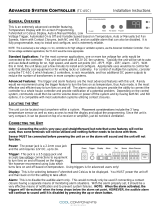
2
I-ZQYRA (08-20) 260414-9
TABLE OF CONTENTS
GENERAL INFORMATION ............................................................................. 4
References ........................................................................................ 4
Important Safety Information........................................................................... 4
Codes and Requirements ............................................................................. 4
Warranty .......................................................................................... 5
Unit Location.......................................................................................5
Receiving, Storage, Moving, and Uncrating ............................................................... 5
Receiving....................................................................................... 5
Storage and Moving .............................................................................. 5
Uncrating ....................................................................................... 5
Dimensions ........................................................................................ 5
Clearances ........................................................................................ 6
Weights...........................................................................................7
INSTALLATION ...................................................................................... 8
Rigging and Lifting .................................................................................. 8
Mounting ..........................................................................................8
Curb Cap Base .................................................................................. 9
Mounting Without Roof Curb ........................................................................ 9
Mounting with Roof Curb........................................................................... 9
Mechanical Connections............................................................................. 13
Unpacking Inlet Air and Exhaust Hood Components .................................................... 13
Installing Inlet Air Hood ........................................................................... 13
Installing Exhaust Hood........................................................................... 16
Inlet and Exhaust Dampers (Option AR2Y)............................................................ 16
Ductwork Connections............................................................................ 16
Installing Condensate Drain ....................................................................... 17
Electrical Connections .............................................................................. 19
Disconnect Switch ............................................................................... 19
Supply Voltage ................................................................................. 19
Supply Wiring Connections ........................................................................ 20
Controls Compartment ........................................................................... 21
Electrical Components............................................................................ 22
Field-Installed Option Connections..................................................................... 25
Discharge Air Temperature Sensor .................................................................. 25
START/STOP Wall Switch (Option CN5) ............................................................. 27
Time Clock Wall Switch (Option CN7A) .............................................................. 27
CO
2
Sensor (Option CN7B) ........................................................................ 27
Indoor Air Quality (VOC and CO) Sensor (Option CN7C) ................................................. 28
Occupancy Motion Sensor (Option CN7D) ............................................................ 29
Remote-Mounted Display (Option RB5) .............................................................. 29
OPERATION ....................................................................................... 33
Unit Control Features ............................................................................... 33
Unit-Mounted Display ............................................................................ 33
ON/OFF Control ................................................................................ 34
Supply and Exhaust Fan Start/Stop Control ........................................................... 34
Unit Occupancy Control........................................................................... 34
Energy Recovery Wheel Control .................................................................... 36
Heat Pump Control .............................................................................. 36
Reversing Valve Operation ........................................................................ 36
Alarms........................................................................................... 37
Service Alarm Modes of Operation .................................................................. 37
Service Alarms ................................................................................. 37
Maintenance Alarms ............................................................................. 39






















